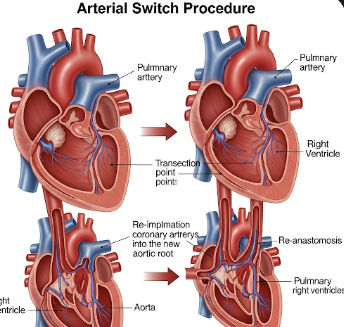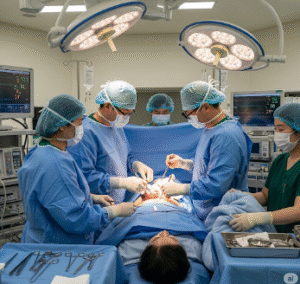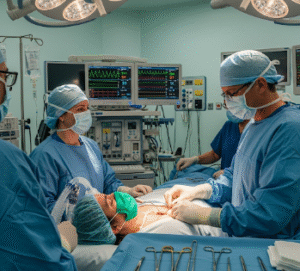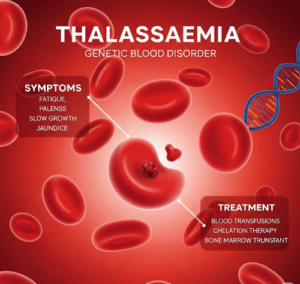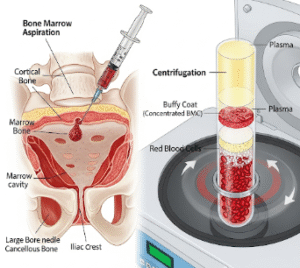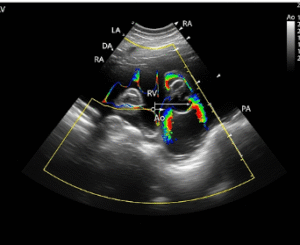Overview
The Arterial Switch Procedure (ASO) is a complex open-heart surgery performed to correct Transposition of the Great Arteries (TGA), a congenital heart defect in which the positions of the aorta and pulmonary artery are reversed. This condition causes oxygen-poor blood to circulate through the body, leading to severe cyanosis (blue skin), heart failure, and life-threatening complications if untreated.
In Korea, the ASO is performed in leading pediatric cardiac centers by highly specialized congenital heart surgeons. The hospitals utilize advanced cardiac operating rooms, state-of-the-art imaging, and post-operative intensive care units (ICUs) to ensure the best possible outcomes. Korean centers also provide family support, rehabilitation, and long-term follow-up care, making them an excellent choice for both local and international patients.
What is Arterial Switch Procedure?
The Arterial Switch Operation involves reconnecting the major arteries to their normal anatomical positions. This procedure:
- Switches the aorta and pulmonary artery to their correct locations
- Reimplants the coronary arteries to maintain heart muscle blood supply
- Restores normal oxygenated blood flow throughout the body
The procedure is typically performed within the first few weeks of life, as early correction improves survival and long-term cardiac function.
What are the benefits?
- Restores normal blood circulation, providing oxygen-rich blood to the body
- Prevents long-term complications, including heart failure, pulmonary hypertension, and growth delays
- Improves survival rates, with most patients thriving into adulthood
- ✅ Performed in highly specialized Korean pediatric cardiac centers, offering excellent success rates
- ✅ Early surgical intervention ensures better heart function and long-term quality of life
- ✅ Minimally invasive strategies in some centers allow reduced trauma and quicker recovery
Procedure Details
1) How should I prepare for the Arterial Switch Procedure?
- ➤ Comprehensive cardiac evaluation, including echocardiography, cardiac MRI, and angiography
- ➤ Blood tests to assess hemoglobin, electrolytes, and clotting factors
- ➤ Preoperative counseling for parents or caregivers about procedure, ICU stay, and post-operative care
- ➤ Discuss medications, anesthesia risks, and perioperative planning with the cardiac team
- ➤ Ensure family support and logistics for ICU and hospital stay
2) What happens during the procedure Arterial Switch Procedure?
- ✅ Performed under general anesthesia in a specialized cardiac operating room
- ✅ Median sternotomy (chest incision) provides access to the heart
- ✅ Cardiopulmonary bypass (heart-lung machine) is used to maintain circulation during surgery
- ✅ The aorta and pulmonary artery are detached and switched to the correct positions
- ✅ Coronary arteries are reimplanted to maintain blood supply to the heart
- ✅ The heart is checked for adequate oxygenation and circulation before closing the chest
- ✅ Surgery duration typically ranges from 4–6 hours, depending on complexity
3) What happens after an Arterial Switch Procedure?
- ➤ Patients are transferred to the Pediatric Cardiac ICU for monitoring
- ➤ Ventilator support is often needed initially
- ➤ Pain management, fluid balance, and medications to support heart function are administered
- ➤ Close monitoring of oxygenation, cardiac rhythm, and vital signs continues for several days
- ➤ Gradual recovery includes weaning from ventilator, feeding, and gentle activity
Risks / Benefits
Potential Risks:
- ➤ Bleeding or clot formation
- ➤ Heart rhythm disturbances (arrhythmias)
- ➤ Coronary artery complications
- ➤ Infection at the surgical site or in the chest
- ➤ Rare long-term complications, including reintervention or residual defects
Benefits:
- ✅ Corrects life-threatening congenital heart defect
- ✅ Restores normal oxygenation and heart function
- ✅ Significantly improves long-term survival and quality of life
- ✅ Performed in Korea with high surgical precision and advanced post-op care
- ✅ Early intervention minimizes risk of neurological and developmental complications
Recovery and Outlook
- Hospital stay: Usually 7–14 days, including ICU monitoring
- Activity: Infants gradually regain feeding, activity, and weight gain under supervision
- Follow-up: Regular cardiology visits with echocardiography and ECGs
- Long-term outlook: Most children grow up with normal heart function, participate in activities, and lead a healthy life
- Lifestyle: Lifelong cardiology follow-up is recommended, but many patients enjoy normal life expectancy
When To Call the Doctor
- ➤ Persistent or worsening cyanosis (bluish skin)
- ➤ Fever, redness, or signs of infection at incision site
- ➤ Difficulty breathing or chest pain
- ➤ Arrhythmias or rapid heart rate
- ➤ Poor feeding or lethargy in infants
Best Korea Option / Process
- ✅ Korea is a leading destination for pediatric cardiac surgery, including ASO
- ✅ Hospitals in Seoul, Busan, and Incheon offer advanced cardiac operating rooms, pediatric ICU, and experienced surgical teams
- ✅ Preoperative assessment, surgery, ICU care, and post-discharge follow-up are fully integrated
- ✅ International patients benefit from VIP coordination, translation services, and family support
- ✅ High success rates with minimal complications and excellent long-term outcomes
- ✅ Comprehensive care ensures lifelong monitoring, rehabilitation, and cardiac health management

